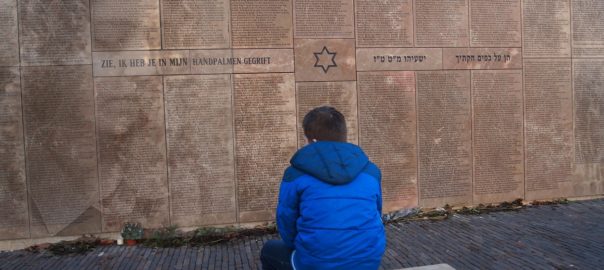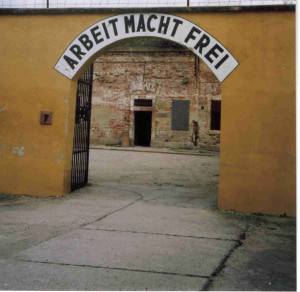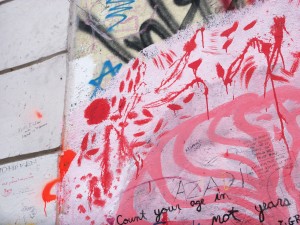students, teaching the Holocaust to this age group is still very challenging.
How do you make the Holocaust relevant to them? And what are some
ways to guide them through this incredibly upsetting subject?
Here is a list of six resources that can help you teach middle schoolers about the Holocaust.
The Butterfly Project
This incredible project uses the arts to educate students about the dangers of intolerance. It makes the Holocaust accessible to children, and presents the subject matter in a way that is poignant but not overly graphic or frightening.
The way it works is as follows: schools order kits containing ceramic butterflies, painting supplies, and cards with biographies of children who died in the Holocaust. After learning more about the children, each student receives a butterfly to paint in memory of them. The school or a community center then install the butterflies as a permanent memorial to the children who died in the Holocaust. The hope is one day there will be 1.5 million butterflies on display around the world, one for each Jewish child the world lost.
Visit their website to learn more about The Butterfly Project or to order a kit.
Inge Auerbacher’s I Am a Star
I Am a Star: Child of the Holocaust tells the story of Inge Auerbacher, a young girl
who survived the war in Terezin. The book is a compelling way to bring the Holocaust to life for your middle school students. Inge is the author of several best selling
books, including I Am a Star, which details her childhood and her time in Terezin.
The book can be purchased on Amazon or through the publisher’s website.
I Am a Star is available in many languages and a 30th-anniversary edition was
recently released. The book was also adapted into an award-winning play, “The Star on
My Heart”, which premiered in Ohio in 2015. Her story has also been featured on Butterflies in the Ghetto.
Paper Clips
This documentary tells the story of a Holocaust memorial project started by teachers and middle school students in the small town of Whitwell, Tennessee.
As part of a Holocaust education project the students began collecting paper clips. Their goal was to acquire 1.5 million to represent each child lost in the Holocaust. The project took off and ultimately the entire community created a remarkable Holocaust memorial outside the school.
The Whitwell community built the memorial in an authentic cattle car from Germany. The result is a starkly beautiful memorial to the children of the Holocaust, and a
powerful message about tolerance and acceptance of others.
Brundibár
Composer Hans Krása and librettist Adolf Hoffmeister created the children’s opera in 1938. Incredibly, Krása was able to stage a production of the musical in Terezin.
The musical was later performed when the Red Cross visited Terezin and featured in a Nazi propaganda film. Tragically, Krása and most of the child performers were later sent to Auschwitz. Very few of them survived the war.
In more recent years, the children’s opera has become more popular. It is certainly a great play to bring to a middle school if possible. There are also videos of the production on YouTube that are worth viewing and discussing with your class. An audio CD of the opera called Hans Krasa: Brundibar is available as well.
Vedem
Vedem is a literary magazine produced by the teenage boys of barrack L417 in Terezin. Fourteen-year-old Petr Ginz established the magazine, and he published a new
issue almost every week. Petr created much of the content himself and the other
boys contributed to it as well.
The magazine featured pieces on daily life in Terezin, satirical essays, poems, and
short fiction, as well as artwork. Tragically, Petr and most of the other boys from barrack L417 died in Auschwitz.
Their legacy lives on in the writings and drawings they left behind. You can read more about Petr Ginz and Vedem here.
I have also created a free Vedem study guide for teachers. The guide is available to
all subscribers to Butterflies In the Ghetto.
Nesarim: Child Survivors of Terezin
This powerful book relates the experiences of 10 boys who were imprisoned in Terezin, in their own words. The book was written by Thelma Gruenbaum, whose husband Michael was in Terezin and whose story is also detailed in the memoir Somewhere There is Still a Sun.
In Terezin, these young boys shared a room with 30 other boys and developed
an incredibly strong bond with one another. They called themselves the
Nesarim, which means “eagles” in Hebrew, and the surviving Nesarim remained
in contact with one another throughout the years.
This book gives readers a sense of what life was like for children in Terezin and preserves the voices of these child survivors so that children of today and future generations can hear and remember their stories.
These are just a handful of resources teachers can use to help their middle school students better understand the Holocaust. I’ve found these to be particularly powerful in bringing stories from the Holocaust to light.
Have you used any of these in your teaching, and what have you found to be helpful? Please let me know in the comments below.



